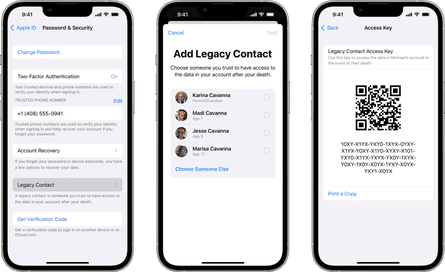Our favourite memories and important documents used to be kept as physical objects: photo albums, scrapbooks, postcards, contracts and certificates of ownership. That meant, when we died, these things would be relatively accessible to the loved ones we left behind.
In the internet era, a lot of that information is stored in the cloud. Everything from photos and videos to emails, documents and contracts, and even social media posts are not easily accessible without legacy planning.
Ghost fares and extensions: what to do with flight credits for Covid cancellationsRead more
Like me, many people also use social media for private journaling of family memories, in the hope those posts can still be seen in the future. Moreover, reminders from social media platforms about a deceased person can be painful and upsetting.
While it is a morbid thought, taking stock of your digital life and planning what will happen when you’re no longer there to log in is critical to ensuring that your information can be easily and responsibly taken care of.
This is an issue that online platforms are increasingly aware of, and many now allow you to issue instructions for what should happen in the event of your death.
Depending on the platform, both preservation and deletion of your account are possible, but it does require forethought, and each platform has a different process.
Apple’s legacy contacts
In December of 2021, Apple introduced legacy contacts, allowing you to choose one or more trusted people to access your account after your death. You generate and share an access key with your nominated contact.
After you die, your contact will need to request access, provide the key you shared, and upload your death certificate to access your Apple account.
 View image in fullscreenSteps to add a legacy contact to your Apple ID. Photograph: Apple
View image in fullscreenSteps to add a legacy contact to your Apple ID. Photograph: Apple
Upon approval, your legacy contact will have three years to view photos, messages, notes, files, apps and other data, and make decisions about what should happen to the information.
Google’s inactive account manager
You can take proactive steps to safeguard the data in your Google account, whether that be photos, documents or even your Google Pay account. Google’s Inactive Account Manager allows you to make a plan for your death, by outlining when Google should consider your account to be inactive. You can set the inactivity waiting period to between three and 18 months. After the set time has elapsed, automated messages will be sent to nominated mobile numbers and email addresses, informing them of the inactivity. You can choose up to 10 people for Google to notify if your account becomes inactive.
You can also choose to share specific data such as Google Calendar, Chrome, Pay, and Photos with nominated people for three months after the account becomes inactive.
Finally, you can also tell Google to delete your inactive account and all of its content. Deletion takes place three months after the account becomes inactive.
Facebook legacy contacts and memorialised accounts
Facebook also allows you to add a legacy contact who can manage your account when you have died. A legacy contact can view private “only me” posts, pin a tribute post, change your profile and cover picture and request the deletion of your account. However, the legacy contact will only be able to perform these activities after the account is memorialised.
 View image in fullscreenAn example of a memorialised Facebook page. Photograph: Facebook
View image in fullscreenAn example of a memorialised Facebook page. Photograph: Facebook
In a memorialised account, the word “remembering” is placed next to your name, and friends and family can share memories on the page’s memorialised timeline.
Facebook memorialises accounts when a family member or close friend lets them know of your death. Lastly, you also have the choice of having your account permanently deleted upon death. If you choose this option, when someone informs Facebook of your passing, the account will be permanently deleted.
Unfortunately, Twitter does not appear to have a way to memorialise an account, nor the ability to provide a legacy contact’s details. It also does not provide account access to anyone regardless of their relationship to the deceased.
Nevertheless, an authorised person or family member of a deceased person can contact Twitter to have the account deactivated, upon providing further information about the deceased, a copy of their ID, and a copy of the deceased’s death certificate.
Instagram, which Facebook owns, has memorialising and deletion features that are similar to Facebook. But it doesn’t offer the option of adding a legacy contact. Instead, anyone can make requests for an account to be memorialised by providing proof of death. Only verified immediate family members or lawful representatives of the deceased can request deletion of accounts.
LinkedIn also does not currently provide a way to give a legacy contact’s details. It only offers the functionality to memorialise or close a deceased member’s account.
-
Sign up for the fun stuff with our rundown of must-reads, pop culture and tips for the weekend, every Saturday morning
Sign up to receive Guardian Australia’s weekend culture and lifestyle email
Family members or authorised persons can only make requests to memorialise or close an account. However, other LinkedIn members can report a deceased person, and upon verification, the account is hidden from public view. Like Twitter, it also does not disclose usernames or passwords to anyone, including family members.
Microsoft
To date, Microsoft appears to have taken a very hands-off approach in dealing with the accounts of deceased users. It does not offer any way of nominating a next of kin to access the account, and the account is inevitably closed after two years of inactivity.
Leaving instructions
Last but not least, you can leave details of all your digital assets – accounts, usernames and passwords – with a trusted friend or family member who can help bring closure. This can be particularly useful for platforms where nominating a legacy contact isn’t possible.
Digital legacy planning may be difficult, but it will make life a little easier for those close to you. After all, you don’t want your online information to be lost or misused when you are gone.
-
Dr Ritesh Chugh is an associate professor in information and communication technologies in the School of Engineering and Technology at Central Queensland University. His research interests include social media and socio-technological aspects of information systems.


